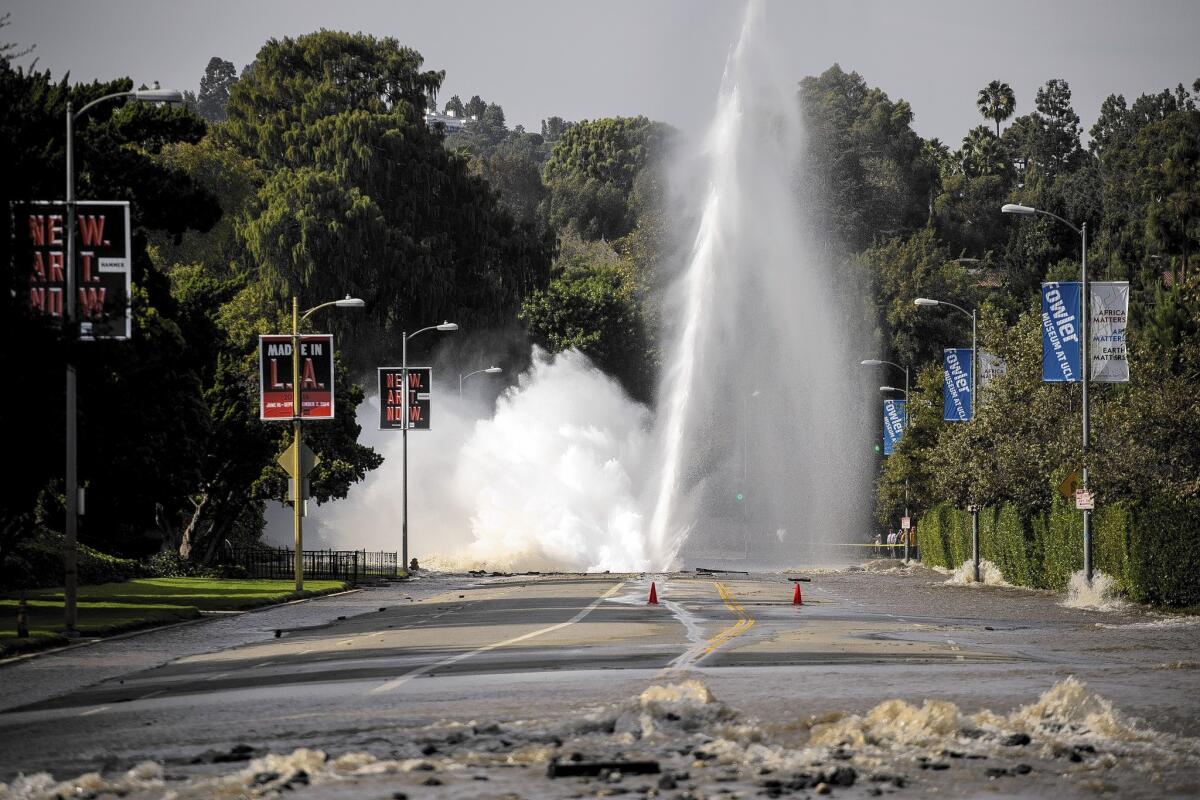Broken Sunset Boulevard water pipe was badly worn, DWP tells council

One of the two water lines that burst under Sunset Boulevard last week was so badly worn that “with a little effort, we could almost scrape the corrosion away and kind of rub a hole through the pipe,” a top Los Angeles Department of Water and Power executive said Wednesday.
Senior Assistant General Manager James B. McDaniel told a committee of Los Angeles City Council members that the other trunk line involved had five leaks before the rupture. Neither line was scheduled for replacement, despite getting less-than-stellar grades of “C” and “D” from the utility, according to DWP officials.
McDaniel and other managers of the city-owned utility were called before the committee to explain what went wrong when broken pipes deluged part of the UCLA campus with about 20 million gallons of water — and what it would take to start mending its woebegone waterworks. Replacing all of its aging pipes could cost billions of dollars.
The two trunk lines, which formed a “Y” shape linking to another pipe dating to the 1950s, were joined by a piece that had been welded using an outmoded and substandard technique, McDaniel said. The joiner appeared to have been “cobbled together” from leftover pieces from another job — “not the most professional type of installation,” he told lawmakers.
McDaniel said there was no way to tell from city records whether other pipe connections across the city had some kind of “Rube Goldberg” construction. In light of the fact that the pipes were not targeted for replacement, city leaders quizzed the executives about whether the DWP could deploy new technology to detect which pipes are most at risk.
DWP officials said in the wake of the UCLA flooding that they might revive an old program that tests pipes by isolating long stretches of water lines and pressurizing them under controlled conditions to check their soundness. Officials said the program was abandoned years ago because so much of the waterworks were being rebuilt that they couldn’t keep taking more pipes out of service for testing — a challenge that should no longer face the city, with more “redundancy” now built into the system, DWP spokesman Joseph Ramallo said.
But McDaniel cautioned that no technological fix would solve the main problem facing Los Angeles.
“We just need to replace more pipe.... We’re not investing as much as we need to be,” he told the committee.
Since 2011, the city has stepped up its budgeted annual spending to replace water mains from $82 million to $112 million, according to the mayor’s office. Los Angeles suffered several other serious breaks in recent years, including one that generated a sinkhole that partly swallowed a firetruck, but McDaniel said Los Angeles has a lower rate of leaks and breaks than the national average, one that has dropped to 15 leaks per 100 miles annually
Even with those improvements, however, the city is replacing its water mains roughly once every 300 years. This year, officials aim to reduce that number to once every 250 years with existing funding, but speeding up upgrades to once a century could take billions of dollars more in investment — and much of it would need to come from ratepayers, McDaniel said. DWP officials said the last time that base water rates were increased was from 2007 to 2009.
Mayor Eric Garcetti has promised not to turn to Angelenos for higher rates on their water and power bills until at least September of next year. But the demand for swifter repairs, as well as steeper goals for energy efficiency adopted earlier this week by the Board of Water and Power, is likely to require added funding.
DWP officials have said they plan to seek a rate increase next year. Utility head Marcie Edwards suggested that a rate hike could have a component devoted specifically to fixing its aging infrastructure. The department probably would seek an additional $500 million to $600 million for the task — amounting to a roughly 2% rate increase per year, she estimated.
Because replacing pipes means tearing up streets, it would take roughly 20 years for the utility to bring its pipe replacement cycle down to 100 years without excessive disruption for residents, Edwards said. At the end of the meeting, City Council members asked DWP leaders to return in a month with plans to improve the city’s water infrastructure over the long term.
The UCLA flooding poured into two underground parking garages and severely damaged more than 300 cars. After praising how effectively city crews had handled the flooding and repairs, Councilman Paul Koretz asked whether the spectacular rupture had provided any lessons to the DWP.
“Unfortunately, I don’t think we learned anything new here,” McDaniel said, adding, “We just have a lot of this in our system.”
[email protected]
Twitter: @LATimesEmily
More to Read
Sign up for Essential California
The most important California stories and recommendations in your inbox every morning.
You may occasionally receive promotional content from the Los Angeles Times.











